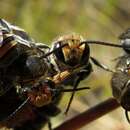en
names in breadcrumbs


The nesting biology of this bee is described by Wcislo and Engel (1996). From Wcislo and Engel (1996) Appendeces 1 and 2: Nests in Soil. Neither turret nor nest chimney is present. The orientation of the main axis of the nest cell is intermediate between vertical and horizontal. The cell shape is radially symmetric. Cells are arranged in the nest in clusters within a surrounding cavity. Cells are not attached to the main tunnel with lateral tunnels. The shape of the pollen mass inside the cell is a slightly flattened sphere. The pollen mass is coated with a secretion. The orientation of the main tunnel in the soil is vertical. The main tunnel has no branches. The nest entrance is not plugged when female(s) leave the nest. cells are not re-used. Nests are dug into horizontal ground. Social behavior, from Wcislo and Engel (1996) Table 1: Communal, possibly semisocial, based on >50 nests from Cabboboonee State Forest, Victoria, Australia.
Vogel and Kukuk (1994) describe the foraging behavior of L. australica (called Nomia australica in the paper). Bees could nest solitarily or in communal groups of two or three. Comparing solitary and two-bee nests showed no difference in ovary size, and females of two-bee nests had no difference in ovary size either, suggesting that both females reproduce. Moreover, marking all bees in the nest showed that both females foraged, and that they foraged at equal rates.